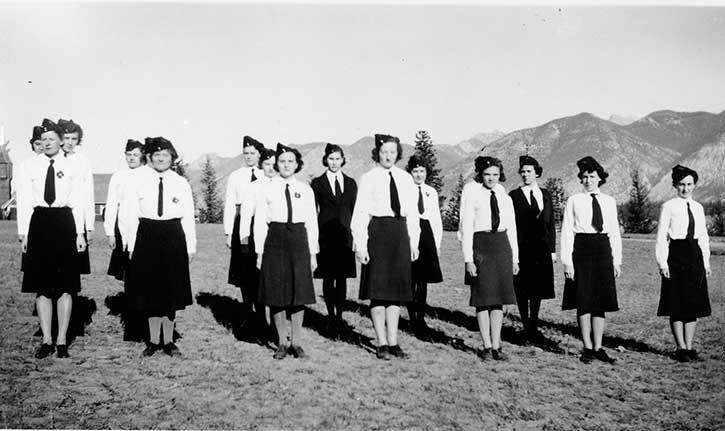Elinor Florence
Special to The Valley Echo
Fearing an enemy invasion, thousands of Canadian girls joined volunteer militia groups during wartime, learning how to conduct air raid patrols, and incredibly, how to handle exploding bombs. And two of them still live right here in
Invermere.
Joy Bond, formerly Joy Johnston, served as the local group’s secretary. Now 97, Joy donated every scrap of paper related to the group to the Windermere Valley Museum. The other woman is Audrey Osterloh, formerly Cleland, now 95.
When Canada declared war against the Third Reich in September 1939, boys flocked to join up. At the time, women were not allowed to join the armed forces, so they started their own quasi-military groups all over the country.
The Windermere Valley group formed in September 1941 with 20 members. It was Branch 10 of 11 groups in the province belonging to the Canadian Women’s Training Corps.
While the boys in uniform were getting free room and board and a salary, these girls were paying their own expenses. Local members paid $1.50 each to join up, and then 25 cents per month.
They paid for their own uniforms, ordered from Vancouver — $23 for an officer and $13 for other ranks — consisting of a navy blue tunic and skirt, white blouse, black tie, and and low-heeled black shoes. Most of the girls sewed their own uniforms to save money.
At the time they joined up, Joy was working at Invermere Hardware, and Audrey at the Imperial Bank of Canada. Some other members were Phyllis Hunt, Alice Jones, P.M. Hewitt, Jean Blake, Doreen Johnston, Mary Dufault, Clare Docker, Edna Robson, Winnifred Weir, Dorothy Tegart and Eleanor Steel.
Training took place one night a week and included Military Drill, First Aid, Morse Code, Motor Mechanics, and Air Raid Precautions. Pages of notes describe bombs used by the enemy —explosives, incendiary or gas — their effects on the human body, and how to treat the victims.
It may seem funny now to think that the girls were preparing for an enemy attack by the Japanese, but perhaps not so far-fetched after the terrifying surprise raid on Pearl Harbour in December 1941.
The girls trained hard physically, too. They made route marches up the long hill beside Lake Windermere, a distance of about six kilometres, wearing their skirts and their sensible shoes.
Meticulous track was kept of attendance. As noted on one attendance sheet, Audrey Cleland received “disciplinary action,” but she couldn’t remember why. “It was pretty hard to get into trouble when all the boys were gone!”
The girls earned military ranks similar to those of the armed forces. Joy was promoted to sergeant, although it cost her five cents. She had to mail a nickel to Vancouver for her sergeant’s chevron, which she then sewed onto her uniform.

When Canada did allow women to join the armed forces two years after the war began, many militia members were first in line. Hats off to Joy and Audrey, and thank you for being prepared to defend Canada.
Elinor Florence of Invermere is the author of a wartime novel called Bird’s Eye View. Signed copies can be purchased from the Invermere Public Library, with proceeds towards the library. For more information visit her website at www.elinorflorence.com or call her at 250-342-0444. To learn more about Joy and Audrey’s wartime experience, please visit www.elinorflorence.com/blog/women-militia.
